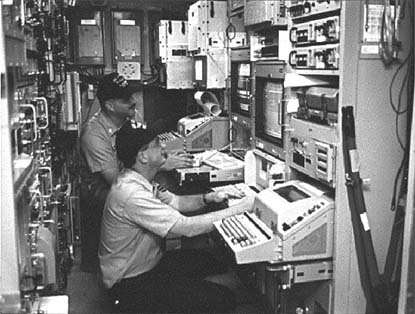SUBMARINE EXTERIOR COMMUNICATIONS SYSTEM (SubECS)

|
The Submarine Exterior Communications System (SubECS) is an umbrella program, which integrates 15 smaller acquisition programs and Commercial Off-the-Shelf (COTS) components into a system that supports Network Centric Warfare. The goal of this effort is a communications system that is common across all submarine classes, is interoperable with the planned DoD C4I infrastructure, and will support the Navy's Copernicus Information System Architecture, the Joint Technical Architecture, the Global Command and Control System Maritime, and the Joint Maritime Communications System.
SubECS will support the steady infusion of new technology and the modernization and replacement of obsolete equipment to allow prompt, sustained, and synchronized operations with Joint U.S. and multinational forces.
SubECS upgrades the communications systems of all existing and planned submarines (Los Angeles Class, Seawolf Class, Trident Class, and Virginia Class) and is being fielded in four major phases. Phase 1 will provide increased interoperability, data rate, and aggregate throughput to the submarine; Phase 2 will provide enhanced message processing and distribution; and Phase 3 will replace remaining legacy transceivers and cryptographic hardware with digital modular radios and programmable cryptographic solutions. During these phases, software and hardware upgrades to equipment from previous phases will be implemented as necessary to keep up with commercial technologies. By Phase 3, a functionally common radio room baseline will exist for all in-service submarine classes. The Virginia Class (SSN 774) ECS is being developed and integrated as part of new construction using the construction shipyard as the integrator. The Virginia ECS will build on SubECS Phase 3 and is the Phase 4 of SubECS. The goal for the out-years is that all in-service submarines will be upgraded to the Virginia ECS plus any necessary technology insertions, maintaining a common state-of-the-art radio room on all submarine classes.
BACKGROUND INFORMATION
The test concept for SubECS involves operational testing for each smaller sub-component and end-to-end system testing for each major phase. Each sub-component program will undergo operational testing before it is introduced into the Fleet. Each SubECS Phase will undergo a land-based Operational Assessment and land-based TECHEVAL, which will be used to certify the system for installation on a submarine. Subsequent to on-board installation, each SubECS Phase will then undergo an at-sea TECHEVAL (for those tests not completed in the land-based radio room) and an OPEVAL. The Virginia Class ECS land-based testing will occur in the Combat Control System Module Off-hull Assembly and Test Site during Virginia class submarine construction at the Electric Boat Company in Groton, CT. At-sea operational testing of the Virginia ECS will occur concurrently with the overall OPEVAL of the USS Virginia (SSN 774).
In June 2000, FOT&E was satisfactorily completed in the Trident submarine variant of the Submarine Low Frequency (LF)/Very Low Frequency(VLF) Versa Module European Bus (VMEbus) Receiver (SLVR), which incorporated the new KOV-17 embedded encryption device, a space-saving improvement. SLVR is now being introduced to fleet Trident submarines and to some Los Angeles submarines.
TEST & EVALUATION ACTIVITY
The first phase of TECHEVAL for the SubECS Phase 1 program was conducted at the Land Based Submarine Radio Room at the Naval Undersea Warfare Center Division, Newport, RI, during February and March 2001. The second TECHEVAL phase will be conducted on an operational submarine platform. At-sea OPEVAL is scheduled for FY02 on a Los Angeles class SSN.
An OPEVAL was conducted by COMOPTEVFOR of the Submarine High Data Rate (SubHDR) Antenna System in USS Providence (SSN 719) in March 2001. A maintenance demonstration was conducted at the Submarine EHF Satellite Communications Integration Facility Lab, Naval Undersea Warfare Center, Newport, RI. Due to satellite limitations, the scope of OPEVAL was limited to testing Extremely High Frequency Low Data Rate capability on those satellites available to the test platform. Additional system performance capabilities will be tested during a phase of FOT&E. These limitations excepted, all test objectives were accomplished.
TEST & EVALUATION ASSESSMENT
Operational testing occurred on SubECS sub-components in accordance with their individual Navy-controlled TEMPs, and FY01 saw the start of the first SubECS integrated phase testing in accordance with the Captstone TEMP. The introduction of the Capstone TEMP will provide Virginia and all in-service submarines with a framework in which formal communications system requirements can be addressed. DOT&E concurs with the dual strategy of testing both individual subsystems and major system upgrades.
The Virginia ECS program implemented a phased delivery approach to mitigate risk that delays the selection of a final configuration as long as possible to reduce changes, both anticipated and unanticipated, in the Navy's C4I acquisition programs. Virginia's limited ECS space-9 rack versus 14 on Los Angeles class-also makes it important to delay Virginia's final configuration as long as possible in order to take best advantage of the latest miniaturization developments. DOT&E continues to evaluate the Virginia risk as moderate but acknowledges that the Navy's approach seems sound. Navy initiatives to field an early Virginia ECS build on the Seawolf class, if funded, would further reduce risk, at least to the Virginia class ECS.
Significant delays in the launch of MILSTAR satellites has pushed complete Submarine High Data Rate (SubHDR) antenna operational testing to several years past the fleet introduction date. The Navy decided to operationally test the SubHDR antenna in FY01 as much as practicable and proceed on with fleet introduction, even though the antenna's higher data rate capability cannot be tested until a MILSTAR II becomes available. DOT&E agrees that this course of action, although not ideal, is a reasonable approach.
|
NEWSLETTER
|
| Join the GlobalSecurity.org mailing list |
|
|
|

